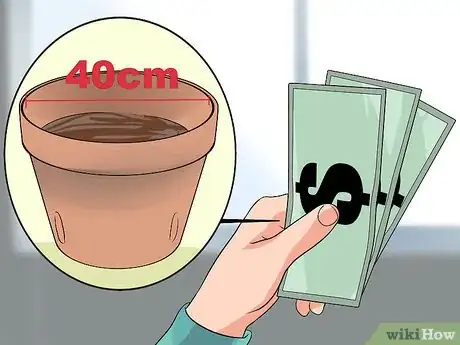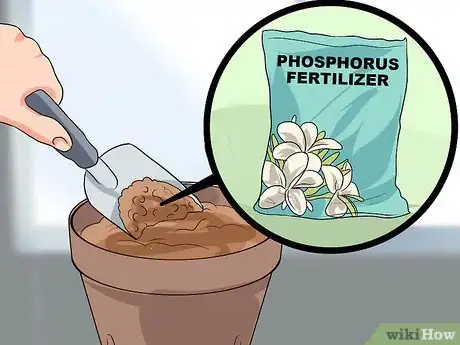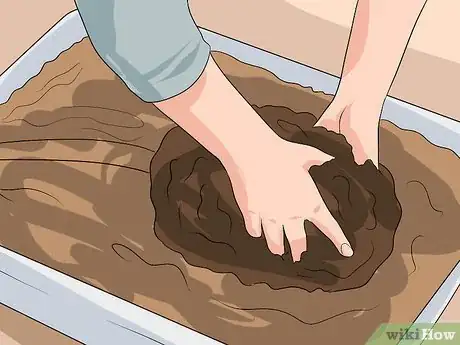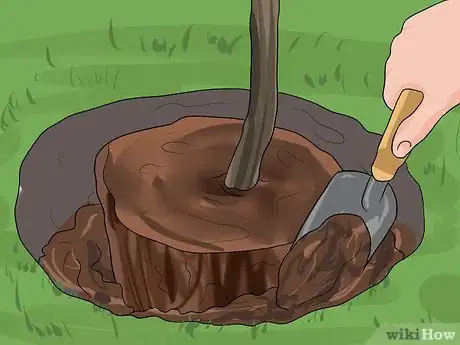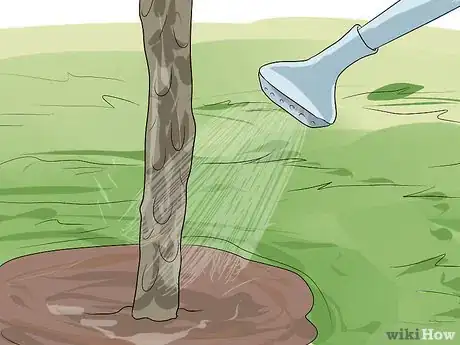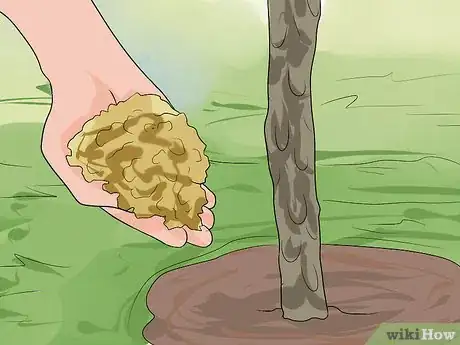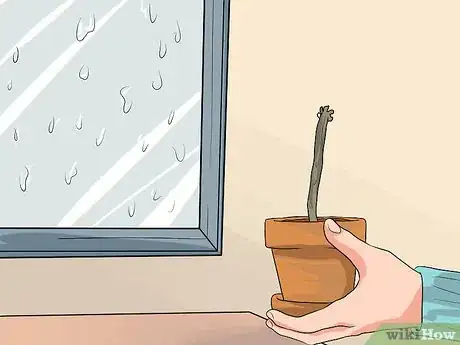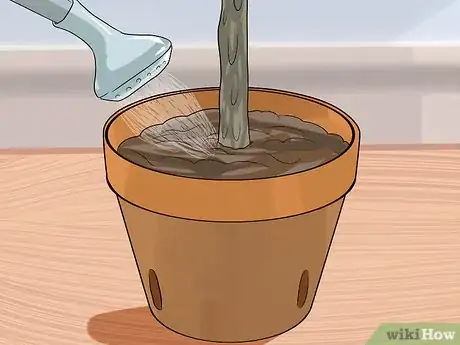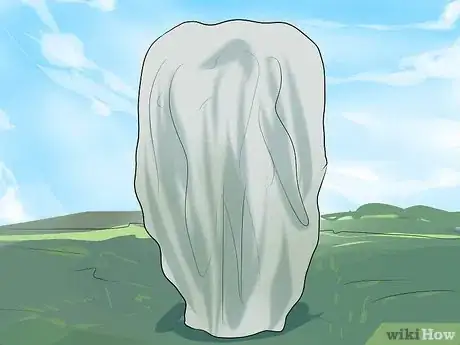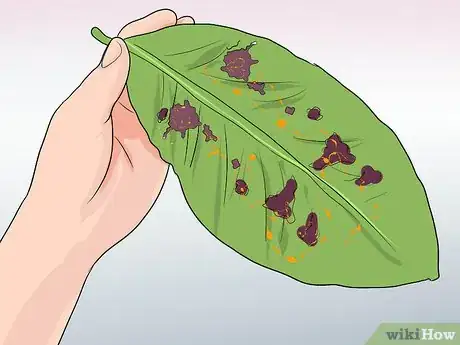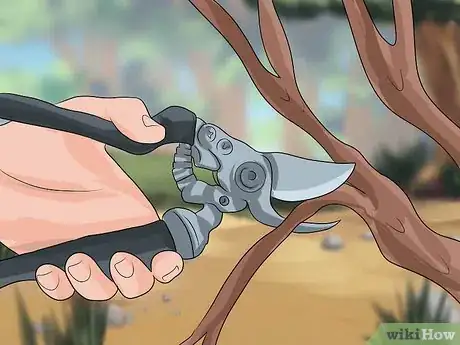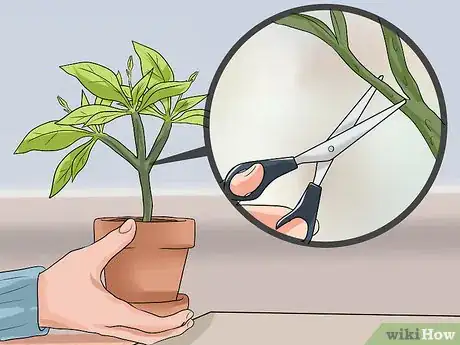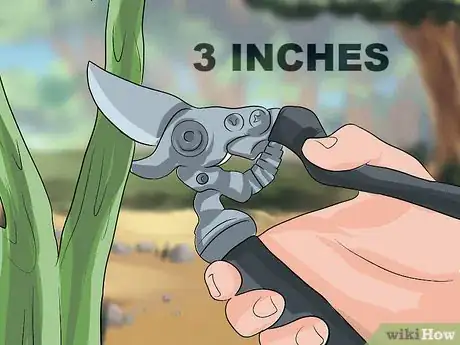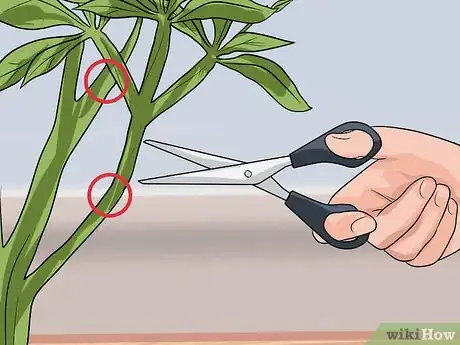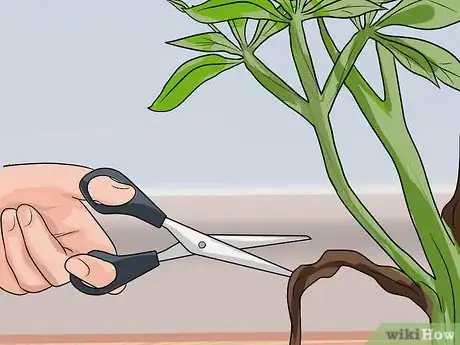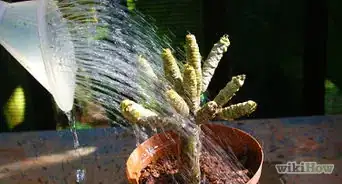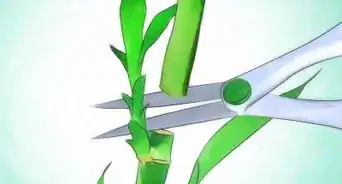This article was co-authored by Katie Gohmann. Katherine Gohmann is a Professional Gardener in Texas. She has been a home gardener and professional gardener since 2008.
This article has been viewed 105,816 times.
Frangipanis, also called plumeria, are popular tropical trees that can be planted in the ground or grown in containers. The branches of these trees are covered with bright, fragrant flowers in various colors. They are easy to care and withstand drought, extreme heat, and even temporary neglect. You can purchase a mature plant or use a cutting to propagate your own. Proper care for frangipanis is simply a matter of thoughtful planting and proper seasonal care.
Steps
Planting Frangipanis
-
1Decide between planting in the ground and in a large container. Frangipanis prefer to be in the ground but also do well in terra cotta containers. They go dormant in winter, but cannot withstand frost. If you live in a place with harsh winters (temperatures below freezing), a container is best so the plant can be moved inside or stored during winter.
- Early spring is the best time to plant a frangipanis so it is established and blooming heavily by summer.
- Plunging, or burying a potted plumeria in the ground, can be done in cooler climates. This way you can keep your plant in the ground, yet still be able to easily move it inside during winter.
-
2Plant or place your plumeria in a sunny place. Choose a spot where it will get at least 6 hours of sun daily. You may also want to plant it somewhere you will be able to enjoy the lovely scent its flowers produce. Great locations include placing them near patios and windows, or beside driveways and walkways.
- If you have a patio or deck with outdoor seating, plant your frangipanis nearby so you can see and smell the beautiful blooms all summer. Or, if using a container, find a sunny spot on the deck to keep it.[1]
- Their shallow roots make them well suited for planting along pathways and other hardscapes, like pools and water features.
Advertisement -
3Dig a hole or purchase a large terra cotta container for your plant. Your hole should be as deep as the root ball and three times as wide. It may help to loosen the soil first by digging in with the tip of your shovel several times, wiggling your shovel around each time to break up the dirt. Containers should be at least 40 cm (15¾ inches) in diameter.
- Terra cotta pots absorb heat, helping simulate a tropical environment for the roots, and provide good drainage since they are porous. They are also usually top heavy, which will help support the plant as it grows.
- You can use a plastic pot if you prefer or want a cheaper, decorative option, as long as you If you take special care to use a good quality, well-draining soil.
-
4Mix in fresh soil and high phosphorus fertilizer. When planting, you may find the soil has poor drainage, like clay or silt, when you dig into it. You will need to mix this with compost or commercial soil made for dry-loving plants before planting. Containers should be filled with premium potting mix with no added wetting agents.
- Cactus mix is a good option, or you can mix regular potting soil with pearlite or orchid bark.
- Place large rocks or broken pot fragments in the bottom of containers before adding any soil, so holes don't become clogged.
- The best kinds of water-soluble fertilizers you can use will have a phosphorus content 50, fertilizers can get as low as 20, but higher content is OK as well.[2]
-
5Loosen the root ball. Use your hands to loosen the soil at the very bottom of the root ball and gently spread the roots out. Failing to separate the roots makes your plant susceptible to root rot.
- If the plant is already root bound, meaning the roots have grown around and filled the pot, you need to use a planting knife to cut them apart before planting.
- When using a root knife, make three vertical incisions near the bottom of the root ball, a few inches deep with each cut running through the bottom.
- To separate the root ball, use your hands to pull apart the roots from each other so they grow in different directions.
-
6Plant the root ball. If your pot or hole is deeper than the root ball, add some soil first. When planting in a container, you should only have a few inches separating the top of the root ball and the top of the container. Cover the root ball halfway with soil, water thoroughly, and allow it to drain. Fill rest of container or hole with soil and pack it down to support the trunk.
- Watering the soil at midpoint will help it to settle and eliminate air pockets around the roots.[3]
- Be sure not to cover any of the exposed trunk with added soil. You only want the tree to be planted as deep as it was in its original container.
-
7Water your tree thoroughly. For containers, the plant will have enough water when you see excess start to come out the bottom holes. Trees planted outdoors should be well watered after planting, but moderately throughout the spring and summer months, especially while the tree is young.
- A good technique for potted watering is to water until it pools, wait 30 seconds for it to drain, and continue this until you see drainage.
-
8Add mulch or moss. Mulch and moss help retain moisture in ground soil longer in hot, dry climates. Whichever you choose to use, make sure it doesn’t touch the trunk or the plant could develop fungal decay from too much moisture.
- For plants growing in containers, you could dress the container with Spanish moss. Be sure to keep it lose around the trunk.
Keeping Your Plumeria Healthy
-
1Store your plumeria during winter. You should bring your frangipanis inside when temperatures starts getting toward 40°F (4.4°C) or so. Store it in a dry, ventilated area that stays above freezing. Remove all leaves from the plant before storing.
- Return your plumeria to the outdoors after winter storage when the temperature most nights reaches 50° or above. Place the container in a sunny spot or plant it wherever you want and water thoroughly.
-
2Water moderately. Frangipani can withstand drought conditions and do not like staying wet. Overwatering can cause root rot. If planted in the ground, they need only an inch of water per week. Container plants generally need more regular watering. Do not water at all during winter months when plant is dormant.
- Begin watering your frangipanis for the season at the first sign of leaf growth.
- Stop watering when leaves begin to drop in the fall. This means the plant is starting to go dormant for the season.[4]
- Keep a rain gauge in your garden to measure weekly rain and/or the amount of water accumulated from sprinklers.
- Water containers until water comes out the drainage holes, then wait to water again when the first few centimeters of the soil becomes dry.
- Check the drainage holes of potted plants periodically and make sure they have not become clogged.
-
3Fertilize twice a month in spring and summer. Start with the first feeding in early spring when the frangipanis comes out of dormancy and leaves are at least 2 inches long. Always use a fertilizer with high phosphorus content. In most cases, this will involve sprinkling one tablespoon per five gallon pot onto soil and watering.
- In early spring, use a 15-15-15 mix. (Phosphorus is the second number displayed.)
- In April, switch fertilizers to a 6-20-20 blend with micronutrients.
- Use 0-40-0 when buds start forming.
- For the last feeding of the season in early fall, use 6-20-20.
- Frangipanis stop growing when the average temperature is consistently below 65°F (18.3°C). In Southern areas, they may bloom through November, but watch the nighttime temperatures in your location carefully to know when to stop feeding it.
-
4Prevent frost damage in winter. For plumeria planted outside, use a frost cloth to cover the whole tree if nighttime temperatures are going to drop below 33°. Use a cloth big enough to come to the ground on all sides. Remove the cloth during day when its sunny or if it will rain. Rain could weigh the cloth down and break limbs.[5]
- If your plant gets frost damage, the ends of branches will turn brown and the tips may turn black. Cut off any black parts and check brown sections for firmness. Any soft spots should be cut off, also.
- Treat the cut ends with a fungicide to prevent further damage to the wounded part of the plant.
-
5Watch for rust on leaves. Rust is a fungus that looks like rust on metal. If you see signs of rust, remove all heavily affected leaves. Spray the rest of the tree with a mix of one heaping tablespoon of baking soda, one tablespoon of Neem oil, a few drops of dish soap mixed with a gallon of water. Use a tank sprayer, and spray once a week until no signs of rust are visible.
- Do not spray in the middle of the day in summer or you might burn the leaves. Spray in the morning or evening when the plant isn’t getting direct sunlight.
-
6Monitor for pests. If you have malformed leaves, tiny holes in your plant, or a sudden loss of leaves, you might have a pest in your frangipanis. Look out for spider mites, scale insects, whiteflies, and mealybugs. Dust or spray your plant with an insecticide to get rid of them.[6]
Pruning Your Frangipanis
-
1Prune young trees yearly. Trimming branches helps shape your plumeria and encourages growth the following year. The beginning of winter is a good time to prune your tree, just before storing for the season. Established, mature trees only need pruning to keep them at their preferred size, or if they have damaged or diseased limbs.[7]
- Plumeria are considered young for 3 or 4 years. After this, they only need to be pruned when they outgrow their space or require shaping.
- Never remove more than 10% of the branches to avoid stressing your frangipanis and inhibiting new growth.
- Blooms only grow at the end of branches and take two years to form on cut branches. Consider pruning only half of the tree one winter, and the other half the following year to maintain seasonal flowering.
-
2Move your tree into a shady area for pruning. Frangipanis should not be exposed to direct sunlight during pruning or in the few days following it. If your plumeria is planted in the ground, wait until the sun is less intense and no extreme weather is expected for a few days.[8]
-
3Cut no more than three inches (7.6 cm) off main stems. Doing this the first few years will encourage trees to produce more branches and become fuller. Use hand pruners and cut the stem at an angle. After cutting, the trimmings can be put in a vase, composted, or thrown away.
- Always wear work gloves and safety glasses when cutting. Branches ooze a milky sap when cut that can irritate skin.
-
4Remove or cut down subordinate stems. Frangipanis tend to produce more than one main stem, which will change the shape of your tree by making it more bushy. Trim down any stems competing with the main trunk, or cut them off close to the beginning of the branch.[9]
- Shortening branches encourages new shoots to grow out of the branch, making your tree fuller. If you want a branch to grow new shoots, do not cut it closer than 6 inches to the main trunk.
- Exactly where you trim your frangipanis and how much depends on your vision for the tree. Air on the side of caution to avoid over-pruning. You can always make a second round of cuts.
-
5Remove crowded, damaged, and infected limbs. This will open up the remaining branches to sunlight, prevent the spread of disease, and allow the tree to become stronger. Cut close to the main stem at an angle.[10] You may also cut any branches that grow in odd directions to create the shape you desire.
- You may also remove lower limbs to create a canopy shape and keep the branches off the ground.
- Any limbs that look diseased, have been damaged by frost or exposure, or are infested with beetles should be cut and disposed of as soon as possible.
- Trim away any noticeable damage, infestations, or sickness as soon as you notice. Waiting may cause any of these to spread.
Expert Q&A
Did you know you can get expert answers for this article?
Unlock expert answers by supporting wikiHow
-
QuestionWhy are the leaves starting to turn yellow?
 Katie GohmannKatherine Gohmann is a Professional Gardener in Texas. She has been a home gardener and professional gardener since 2008.
Katie GohmannKatherine Gohmann is a Professional Gardener in Texas. She has been a home gardener and professional gardener since 2008.
Professional Gardener Yellow leaves can mean a couple things. Sometimes that indicates over- or under- watering. Make sure you let your plants dry out a bit before watering them. It might also be caused by bugs or disease. Check for any bugs on the leaves (make sure to check the undersides!) and get rid of them. If your plants are diseased, unfortunately there isn't really much to do but throw them out (don't compost) and start over.
Yellow leaves can mean a couple things. Sometimes that indicates over- or under- watering. Make sure you let your plants dry out a bit before watering them. It might also be caused by bugs or disease. Check for any bugs on the leaves (make sure to check the undersides!) and get rid of them. If your plants are diseased, unfortunately there isn't really much to do but throw them out (don't compost) and start over. -
QuestionWhat do I do if the leaves on my frangipani branches have all gone limp?
 Katie GohmannKatherine Gohmann is a Professional Gardener in Texas. She has been a home gardener and professional gardener since 2008.
Katie GohmannKatherine Gohmann is a Professional Gardener in Texas. She has been a home gardener and professional gardener since 2008.
Professional Gardener
-
QuestionWhat fertilizer should be used for potted frangipani?
 Community AnswerThe best kind of fertilizer for your frangipani will be rich in in nitrogen, potassium (or potash) and phosphorous. For best results, you may even want to use liquid fish fertilizer and a seaweed solution.
Community AnswerThe best kind of fertilizer for your frangipani will be rich in in nitrogen, potassium (or potash) and phosphorous. For best results, you may even want to use liquid fish fertilizer and a seaweed solution.
Things You'll Need
- Frangipanis tree
- Shovel or trowel
- 40” or larger terra cotta pot (optional)
- Watering can or hose
- Well-draining commercial soil
- High phosphorus fertilizer
References
- ↑ http://garden.org/learn/articles/view/2132/
- ↑ https://www.exoticplumeria.com/plumeria-helpful-hints/
- ↑ http://garden.org/learn/articles/view/2132/
- ↑ http://www.tropicamango.com/plumeria.html
- ↑ http://www.tropicamango.com/plumeria.html
- ↑ http://www.paliplumies.com/plumeria_Insects.html
- ↑ http://homeguides.sfgate.com/trim-frangipani-tree-22112.html
- ↑ http://homeguides.sfgate.com/trim-frangipani-tree-22112.html
- ↑ http://homeguides.sfgate.com/trim-frangipani-tree-22112.html
About This Article
Frangipani trees are easy to care for and can do very well in areas with extreme heat and droughts. It’s best to plant a Frangipani in the ground, but if you live somewhere with harsh winters, plant it in a pot so you can move it indoors seasonally. Frangipanis need to be placed somewhere that gets at least 6 hours of sunlight a day. They also need fresh soil mixed with a high phosphorus fertilizer to thrive. Once you plant your Frangipani, water it thoroughly then give it some mulch or moss to help it retain moisture. As it grows, you’ll want to give it an inch of water a week, since these plants prefer dryer conditions. To learn how to prune your frangipanis, read more from our Gardening co-author!


